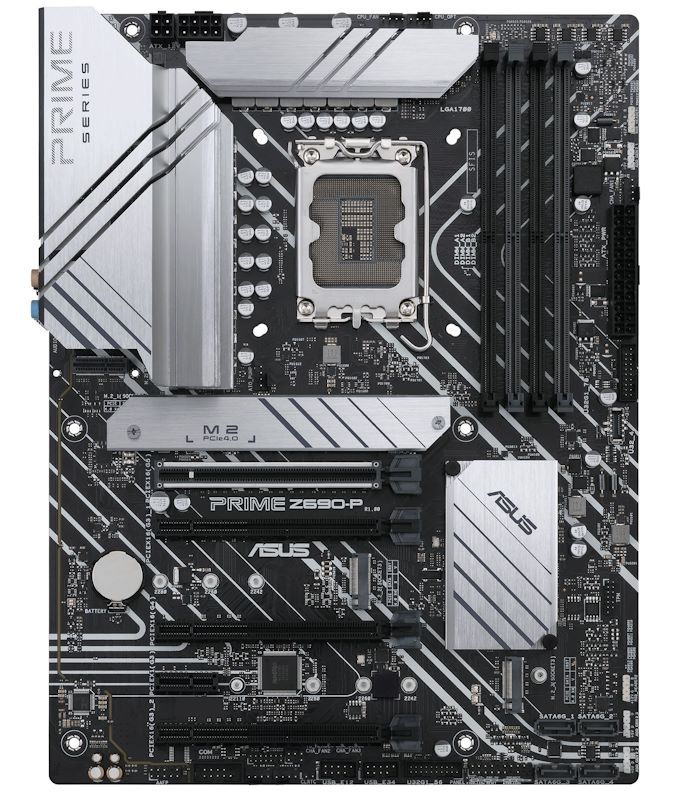The Intel Z690 Motherboard Overview (DDR5): Over 50+ New Models
by Gavin Bonshor on November 9, 2021 9:00 AM ESTASUS Prime Z690-P WIFI (DDR5) & Z690-P (DDR5)
Sitting at the entry-level of the Z690 models from ASUS for the launch of Intel's 12th generation of desktop processors are the ASUS Prime Z690-P WIFI and Prime Z690-P. Both of these models share an identical PCB and aesthetic, with all the same features except one. The Z690-P WIFI includes an Intel Wi-Fi 6 CNVi, while the Z690-P does not. Focusing on the design, the Prime Z690-P WIFI and Z690-P include a black and white patterned PCB, with simplistic silver heatsinks with diagonal lines that fit and match with the rest of the PCB. There is no fancy RGB LED lighting integrated into any section of the board, but ASUS does include three addressable RGB headers and two Aura RGB headers for users to add their own.
Included for PCIe support is a total of five slots that consists of one full-length PCIe 5.0 x16 slot, one full-length PCIe 4.0 x4 slot, two full-length PCIe 3.0 x4 slots, and one smaller PCIe 3.0 x1 slot. For storage, there's three PCIe 4.0 x4 M.2 slots, with one of these supporting SATA drives too. Both the ASUS Prime Z690-P WIFI and Z690-P also include four straight-angled SATA ports that can support RAID 0, 1, 5, and 10 arrays. ASUS has also provided four memory slots that are capable of supporting up to DDR5-6000, with a combined capacity of up to 128 GB.

The ASUS Prime Z690-P (without the Wi-Fi 6 CNVi that the Z690-P WIFI includes)
The only difference between both the Prime Z690-P WIFI and Z690-P is that the WIFI version includes an Intel Wi-Fi 6 CNVi, while the other does not. Everything else is the same, including one USB 3.2 G2x2 Type-C, one USB 3.2 G2 Type-A, two USB 3.2 G1 Type-A, and two USB 2.0 ports. There's also one Realtek RTL8125 2.5 GbE port, a PS/2 combo port, and five 3.5 mm audio jacks and S/PDIF optical output powered by an unspecified Realtek ALC HD audio codec.











126 Comments
View All Comments
DanNeely - Tuesday, November 9, 2021 - link
Good point. I thought Intel was pushing hard for 12vo with the 6xx series, but it seems to be completely MIA.Silver5urfer - Tuesday, November 9, 2021 - link
Can I ask why ? What does ATX12VO provide to a consumer ?It doesn't make your mobo cheap, it doesn't make your mobo less complicated, it does not make your system run cooler, it doesn't make ADL consume less power, It doesn't even make any sense.
ATX12VO was created because of that trash policies set by policing state of California about some nonsensical rubbish. Servers and Data centers can get away with modular high density PSUs because of fully standardized set and they also get 3M liquid cooling. This is consumer market and here we have people wishing for backwards in technology.
meacupla - Thursday, November 11, 2021 - link
A lot of people had the same sentiment about EU RoHS restrictions, and yet, it was implemented worldwide.With that attitude, the same can be said about energy star, and 80plus certifications. It adds cost to the product, yet it offers not a thing to the consumer.
Not everything is about you.
We need to do everything we can to cut down power consumption, and ATX12VO standardization across the entire industry is very low hanging fruit.
Stop being so selfish, there's literally only one habitable planet we have right now.
Oxford Guy - Thursday, November 11, 2021 - link
80 Plus offered plenty to consumers. Less power use means quieter PSUs.The knock on 80 Plus was unrealistically easy testing. Despite that, it helped raise the efficiency of PSUs. Along with better efficiency, ripple, holdout time, voltage consistency, and other factors improved — as enthusiasts began to pay more attention to PSU quality.
I don’t doubt that 80 Plus also helped a lot of non-enthusiasts/amateurs by keeping them away from ultra-cheap PSUs that catch fire. Having a high-profile certification that those PSUs can’t reach helped to steer those customers away.
yacoub35 - Tuesday, November 9, 2021 - link
That white metal trim running tight around the molex power connector on the ASUS ROG Maximus Z690 Formula must make it an absolutely nightmare to plug/unplug the main power cable to the board.Ranguvar - Tuesday, November 9, 2021 - link
Correction:"Previously with 11th gen (Rocket Lake), Intel upheaved it from a PCIe 3.0 x4 uplink on Z490 to a PCIe 3.0 x4 uplink on Z590."
This should say "to a PCIe 3.0 x8 uplink on Z590".
OFelix - Tuesday, November 9, 2021 - link
Correct. And whilst we are correcting that sentence - "upheaved" ????This first page really needs to be read by an AnandTech editor.
What's that? They don't any editors? :-(
OFelix - Tuesday, November 9, 2021 - link
"Z490 Motherboard Audio" ... presumably Z690?mode_13h - Friday, November 12, 2021 - link
I caught that, as well. Even the word "upheaved" is itself somewhat noteworthy. Plenty of better alternatives: "upgraded", "widened", "expanded", "increased", "enlarged", etc.GeoffreyA - Saturday, November 13, 2021 - link
While "upheaved" is likely an error, it's not far off from the words of today. Unfortunately, the English language is on a downgrade, and it's just going to get worse and worse. The language's genius is not tuned to the over-economical forms we're finding today; and a lot of it seems to be coming from tech. Upthis, upthat. My favourite, though, is leverage. A big, scary word that companies are fond of, and which escaped its programming, game development roots. Soon, we'll be leveraging the kettle to make tea. How about using?